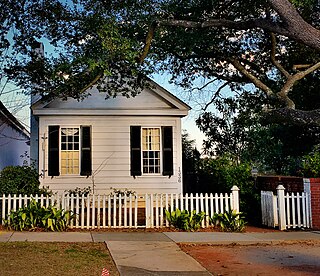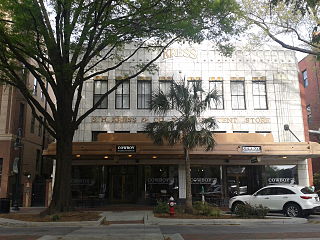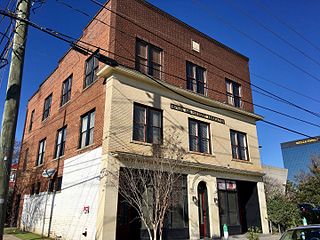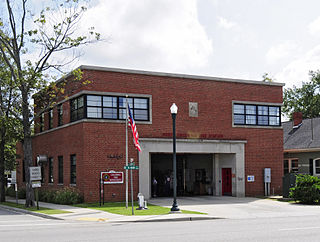
The Zimmerman School is a historic school building located at Columbia, South Carolina. It was built in 1848, and is a small Greek Revival style one-story clapboard building with a gable roof. The school was built by Charles and Hannah Zimmerman, who operated it from 1848 to 1870, and also built the neighboring Zimmerman House.

Horry-Guignard House is a historic home located at Columbia, South Carolina. It was built before 1813, and is a two-story, late Federal style, modified I-house type frame dwelling. The front facade features a one-story, full-width balustraded porch supported by square columns. During the winter of 1813–1814, the main hall was widened from six feet to eleven feet. To do this, the house was sawed in half and the two ends were pulled apart to rest on two new foundations. It was probably built by Peter Horry (1747-1815), a Revolutionary War Colonel and Brigadier General of the South Carolina Militia. Later, the house was acquired by John Gabriel Guignard (1751-1822), the Surveyor General of South Carolina from 1798 to 1802. Guignard is responsible for the early design of the city and laid out the first streets of Columbia.

Sylvan Building, originally known as Central National Bank, is a historic commercial building located at Columbia, South Carolina. It was built in 1870, and is a three-story, brick Second Empire style building designed by Samuel Sloan. It features a slate-covered mansard roof.

Union Station, also known as Atlantic Coast Line Railroad and Southern Railway Station, is a historic train station located at Columbia, South Carolina. It was built in 1902, and is a brick and stone, eclectic Jacobethan Revival / Tudor Revival building. It features stepped gables and towering chimneys. It was designed by architect Frank Pierce Milburn for the Atlantic Coast Line Railroad and Southern Railway. In contrast to the custom of 'union station' denoting the single station for several railroads, the Seaboard Air Line Railroad had its own station one-half mile away. The formerly Seaboard Silver Star still operates through another station in Columbia.

Town Theatre is a historic community theatre located at Columbia, South Carolina. It was built in 1924, and is a rectangular brick building with a two-story glazed central arch with Art Deco influences. A brick annex was added to the rear of the building in the 1950s. It houses one of the first community theatres in the United States.

Building at 1210–1214 Main Street, also known as Capitol Café, is a historic commercial building located at Columbia, South Carolina. It was built by 1871, and is a two-story, seven bay, stuccoed brick building. A cast-iron railing extends across central three bays of the second floor. The Capitol Café was previously located in the building since 1913.

The Bouchier Building is a historic commercial building located in Columbia, South Carolina. It was built in 1913–14, and is a three-story, terra cotta faced building with large areas of glass on the upper floors.

Kress Building is a historic commercial building located at Columbia, South Carolina across the street from the Columbia Museum of Art. It was built in 1934 by S. H. Kress & Co., and is a two-story, Art Deco style building faced with white terra cotta and colored terra cotta ornamentation. It features rounded storefront windows and cornice that contains the word "Kress" and surmounted by a stepped parapet.

National Loan and Exchange Bank Building, also known as the Barringer Building, is a historic bank and office building located at 1338 Main Street, Columbia, South Carolina. It was built in 1903, and is a 12-story, steel frame building faced in brick and stone. It measures 184 feet high and is considered Columbia's first skyscraper. The building was owned by the Barringer Corporation from 1953 until 1974.

North Carolina Mutual Building, also known as the Blue Palace Tea Shop and Barber Shop, is a historic commercial building located at Columbia, South Carolina. It was built in 1909 by the North Carolina Mutual Life Insurance Company, and is a three-story, rectangular, brick commercial block. The building housed African-American businesses, professionals, and institutions during the years of Jim Crow segregation. It is located in the Washington Street business district, the city's black downtown.

Richland Cotton Mill, also known as Pacific Mills, Lowenstein Mill, and Whaley's Mill, is a historic cotton mill building located at Columbia, South Carolina. It was built in 1894, and is a four-story, rectangular brick mill building. It features a seven-story stair tower, with a circular vent flanked by two arched vents. Attached to the building are an engine room, a boiler room with chimney, and a machine shop.
Palmetto Compress and Warehouse Company Building is a historic cotton bale compress facility and warehouse building located at Columbia, South Carolina. The first section of the four-story brick building was built in 1917. The building was doubled in size in 1923.
Southern Cotton Oil Company, also known as Columbia Mill, was a historic cottonseed oil complex located at Columbia, South Carolina. The complex was built between 1887 and 1919. It consisted of seven industrial buildings: the Seed House, Linter Room, Press Room, Machine Shop, Oil House, Cotton Storage Room, and Storage Shed. Five of the buildings were constructed of brick and the other two were constructed of galvanized sheet metal. The complex has been demolished.

Olympia Mill, also known as Pacific Mill, is a historic textile mill complex located at Columbia, South Carolina. It was built in 1899, and consists of a four-story, red brick, rectangular shaped, main mill building connected to a one and two-story red brick power plant. The main building is in the Romanesque Revival style and features terra cotta detailing, large segmental arched window openings, and twin pyramidal roofed towers. The complex also includes: a one-story brick power plant auxiliary building, a one-story storage building, and two small brick one-story gatehouses.

North Columbia Fire Station No. 7 is a historic fire station located at Columbia, South Carolina. It was built in 1948, and is a two-story, brick, transitional Art Moderne / International style building. It features metal window frames, flat roof, and corner ribbon windows.

Good Samaritan-Waverly Hospital, also known as “Good Sam” Hospital and Waverly Hospital, is a historic hospital for African-American patients located in Columbia, South Carolina. It was built in 1952, and is a two-story, brick building in the Moderne style. The hospital housed a pharmacy, laboratory, X-ray room, staff dining room, two operating rooms, and 50 beds to service the local community. The hospital closed in August 1973.

William Jennings Bryan Dorn Veterans Affairs Medical Center is a historic hospital complex and national historic district located at Columbia, South Carolina. The district encompasses 19 contributing buildings and a covered walk. Most of the oldest buildings are two- to three-story brick structures and feature a Georgian Colonial Revival architectural style. The original buildings date to 1932, with additional buildings completed in 1937, 1945, and 1946. A major expansion occurred in the 1970s. In 1978, President Jimmy Carter named the hospital after U.S. Representative from South Carolina, William Jennings Bryan Dorn. The complex includes the hospital, recreation, dining, and residential buildings. The complex is operated by the Veterans Health Administration.

Columbia Central Fire Station, also known as Columbia Fire Department Headquarters and Senate Street Station, is a historic fire station located at Columbia, South Carolina. It was built between 1949 and 1951, and consists of two buildings and a structure. The main building is a two-story, rectangular, brick building in the Moderne / International Style. It has a flat roof and features horizontal bands of windows. The one-story, brick fire truck garage building and the main building were constructed in 1949–1950. The drill tower is a six-story reinforced concrete structure built in 1951. The complex served as the Columbia Fire Department's Headquarters from 1950 until 1995.

Columbia Historic District I is a national historic district located in the Arsenal Hill neighborhood at Columbia, South Carolina. The district encompasses nine contributing buildings and includes a complex of fine mansions and attractive homes built before the American Civil War. The buildings are in the Greek Revival, Italianate, Classical Revival, and the “Columbia Cottage” styles. They include the Governor's Mansion, Caldwell-Hampton-Boylston House, Lace House, and Palmetto Iron Works and Armory.

Columbia Historic District II is a national historic district located at Columbia, South Carolina. The district encompasses 113 contributing buildings and 1 contributing site in a former residential section of Columbia. They were built between the early-19th century and the 1930s and are now mostly used for commercial purposes. The buildings are in the Greek Revival, Gothic Revival, Classical Revival, and the “Columbia Cottage” styles. Notable buildings include the Robert Mills House, Debruhl-Marshall House, Hampton-Preston House, Episcopal Church of the Good Shepherd, Crawford-Clarkson House, Maxcy Gregg House, Hale-Elmore-Seibels House, St. Paul's Lutheran Church, and Ebenezer Lutheran Church.






















